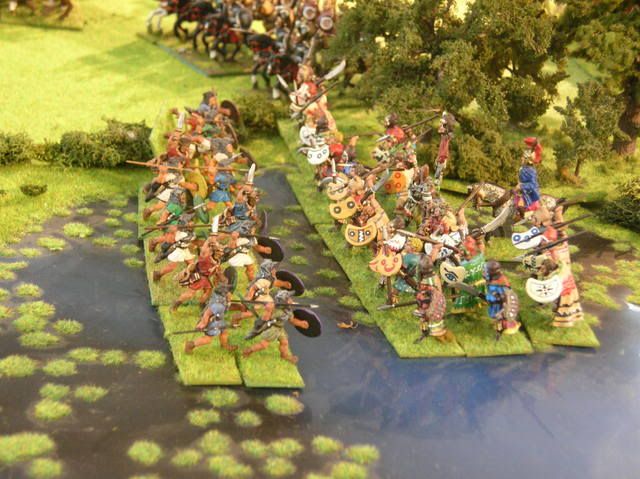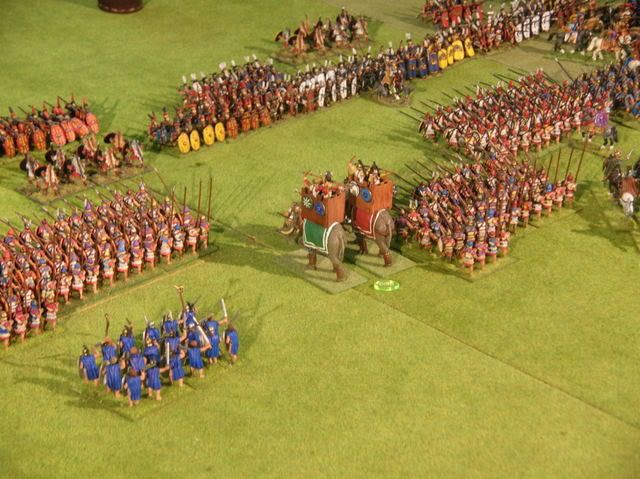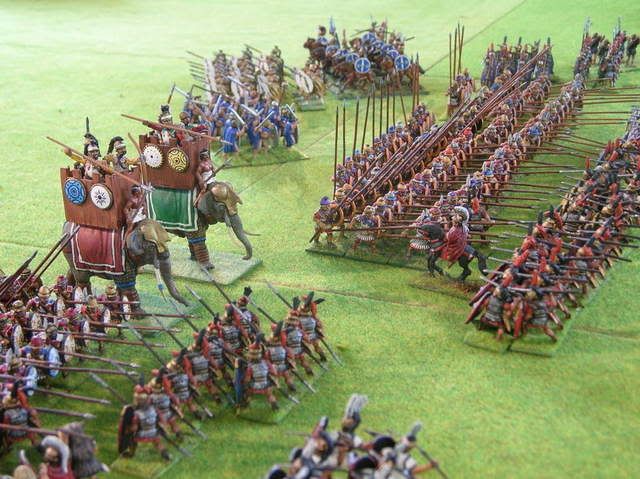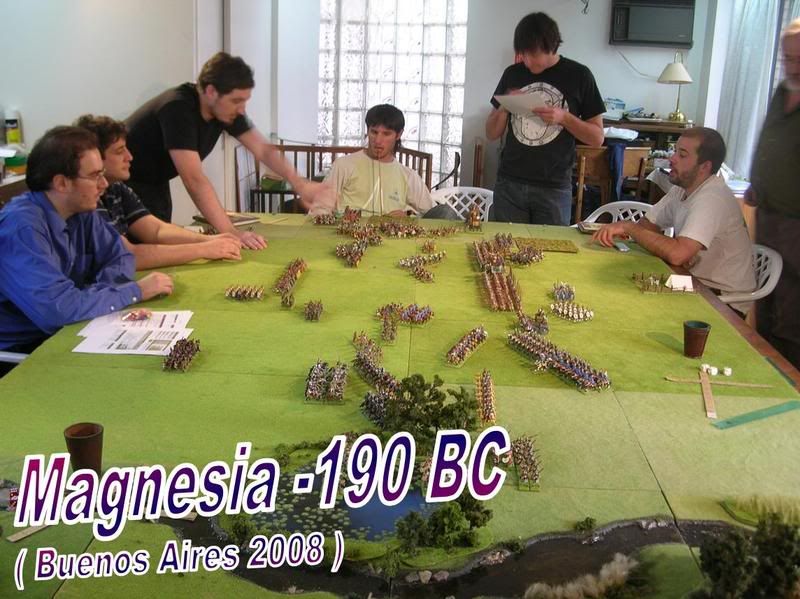
On May 16th taking advantage of a short trip I took home to Buenos Aires Argentina we decided to organize a multi player macro battle to familiarize players with FOG.
The chosen battle to represent was Magnesia due to the great variety of troops available to both sides.
The battle was thought to be a good representation of the historical battle of the end Syrian Wars where Lucius Cornelius Scipio (brother to Scipio Africanus), accompanied by his brother and joined by an allied force led by Eumenes II of Pergamum faced in battle Antiochus III of the Seleucid kingdom.
The historical battle took place in 190 BC when based on what we know the Roman army finally managed to bring the Seleucid army to battle not far from the city of Magnesia in the valley of the river Hermus.
As usual different accounts of the battle exist thought the general agreement appears to be that Antiochus deployed his army with a river on his right flank. He succeeded in breaking one of the roman flanks but failed to exploit this advantage. On the opposite flank an unsuccessful attack with chariots was exploited by Eumenes and when the flank of the pike phalanx battle line fell the Seleucid army was lost.
Representing the historical armies
When building the armies we were faced with the inconvenience that according to most historical accounts the Seleucid army had a considerable superiority in numbers.
In our analysis of the Later Seleucid army list we found that, in order to achieve this balance of force, the quality of the Seleucid army would have to be downgraded; for example having the regular phalanxes as poor and the Agryspides as average.
This made much sense in our view since we do believe that the authors have been a bit to generous with the Later Seleucid army which is stronger in general quality terms even than previous Alexandrian and Successors evolutions. However we decided not to adjust the quality of the Seleucids in order to make sure that we are using the original rules and no house rules, even if we slightly disagree with this interpretation of the later Seleucid quality. After all it is best to run an introductory game without any house rules.
Balancing the opposing forces and establishing “commands”
The solution to the quality and quantity issue mentioned before was to insure a battle balanced on points with armies fully compliant with the army lists. Given that we expected to have about 5 players per side we selected to build armies of about 1500 points. Since the lists are not proportional and going beyond the 1000 point mark is a stretch we multiplied all minimums and maximums by 1.5.
We did use a special rule for this game regarding commanders.
We forced each side to establish lines of command assigning battle groups to specific commanders; hence whenever the rules refer to a commander being in line of command this would only apply to the battle groups assigned to that commander. This served two purposes:
1) Limiting the ability of commanders to pre assigned battle groups meant that the armies were more fragile since it was more difficult to have commanders running around bolstering troops. In a battle with about 22 to 27 battle groups per side that had to be finished in a day (since I was flying back to the US ) more fragile armies seemed like a good idea.
2) Forcing players to command a certain number of units on their own with no interference from their team mates ( no inter team advice was permitted ), we made sure that all players would participate actively
The only exception was that the CiC was allowed to “steal” units from other command while being “with” that particular unit.
We placed 4 commanders per side since, this was the number of players confirmed for the game and when the two additional unconfirmed players showed up they were assigned joint commands with one previous player on each side.
Regarding the troop composition, rather than allowing for customized armies, we the organizers, built armies that in our view roughly followed the variety of troops available in the battle according to the chosen recount of the battle (out of the many different versions available), for example having camels, chariots Galatians etc on the Seleucid army and having Pergamum allies for the Roman army.
Given the “increased size” of the lists for the 1500 points armies, we allowed the Romans to represent the legions as a combination of 4 base and 8 base battle groups as long as the proportion in the lists for triarii and velites was maintained.
As a result we represented the roman core troops in the following fashion with an approx scale of 1 figure being equivalent to something between 90 and 100 soldiers,
2 roman legions:
1 Bg 8 bases of Hastati ( superior and protected )
1 Bg 4 bases of Hastati ( superior and protected )
1 Bg 8 bases of Princeps (superior and armored )
1 Bg 4 bases of Princeps ( superior and armored )
1 Bg 4 bases of Triarii ( elite and armored )
1 Bg 2 bases of Triarii ( elite and armored )
3 Bg 4 bases of Velites
2 allied latin legions )
1 Bg 8 bases of Hastati ( average and protected )
1 Bg 4 bases of Hastati ( average and protected )
1 Bg 8 bases of Princeps (average and armored )
1 Bg 4 bases of Princeps ( average and armored )
1 Bg 4 bases of Triarii ( superior and armored )
1 Bg 2 bases of Triarii ( superior and armored )
3 Bg 4 bases of Velites
As you can see we used the list option of protected for the hastati and armored for the princeps, we decided to use the upgraded legions as “roman” and the regular ones as “latin allied legions”. We allowed this combination of 8 base and 4 base battle groups to symbolize the flexibility of the maniple system. In fact the lists where perfectly matching what the army list allows, but we simply decided to use a figure scale where this number of troops would represent two roman legions and two allied legions.
The full composition of the armies was as follows:
Roman Army
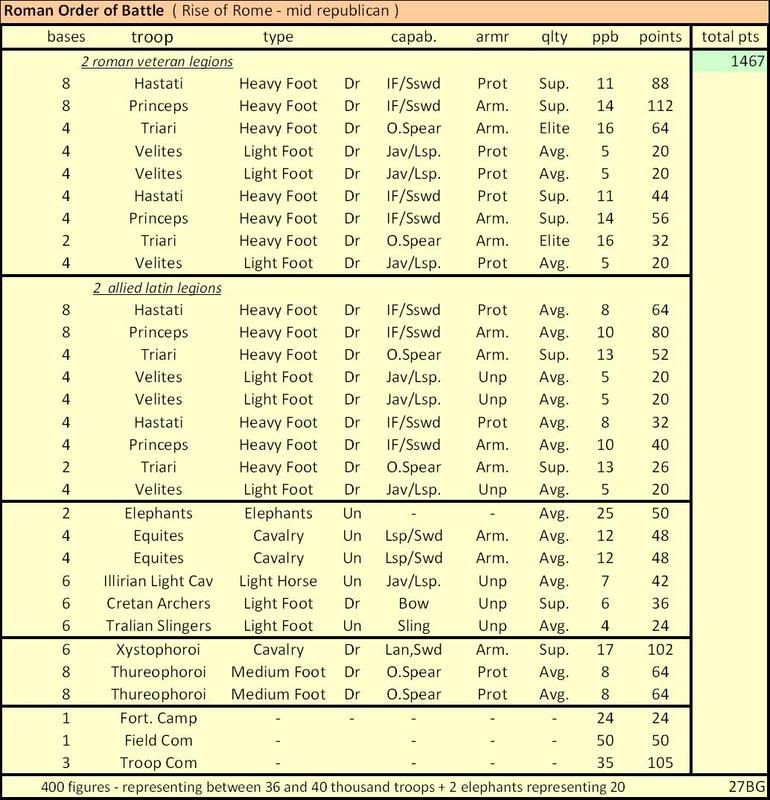
Seleucid Army
(still posting )




































